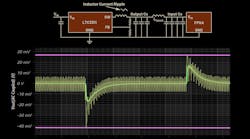How to Reduce the Number—and Size—of Output Capacitors in Power-Supply Designs (Download)
Feb. 11, 2022
A power supply’s output capacitors—which are typically ceramic capacitors with values between 100 nF and 100 μF—cost money, take up space, and, in the case of delivery bottlenecks, can be difficult to obtain. Thus, the question of how the number and size of output capacitors can be minimized arises time and time again.
Two effects of output capacitors are critical here: the effect on the output voltage ripple and the effect on the output voltage after load transients.
First, a general remark should be made about the term “output capacitor.” These capacitors can be found on the output of a power supply. However, many electrical loads (power consumers), such as FPGAs, require a certain number of input capacitors.
Comments
Comments
